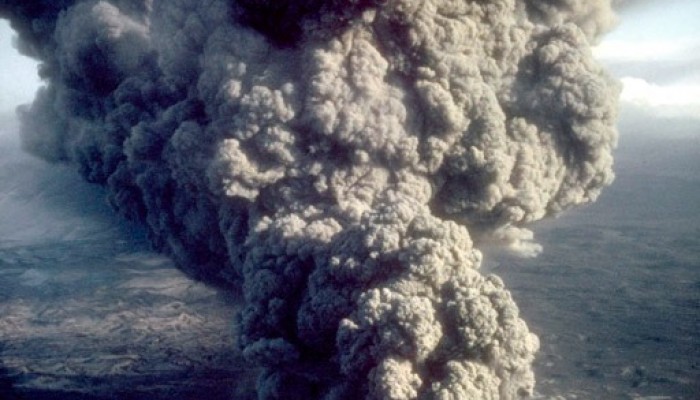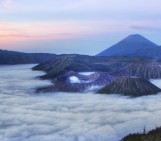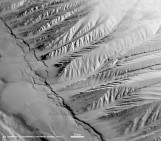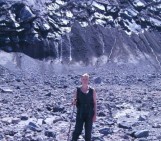
Following his session at the EGU General Assembly, Greg Valentine (Buffalo University) spoke to Sara Mynott about how he creates model volcanoes, specifically maar-diatremes, and blows them up to better understand what goes on in an eruption…
So what is a maar-diatreme?
A diatreme is a vent-like structure, mostly made up of broken up bedrock and magma. Initially, you have a dyke that channels magma straight up to the surface, but somewhere along the line the magma interacts with groundwater. This causes explosions below ground, which start to build up zones of debris. Once you get a debris-filled zone, the magma comes up in fingers that probably facilitate further interaction with water.
Tell me a little about your experiments…
We have an experimental site near Buffalo, New York. It’s out in the countryside, so we can be messy and loud.
We dig a trench (20m long, 4m wide and 2m deep) and make craters between 1 and 2 metres in diameter. It’s like landscaping. We have a guy who normally works in gardens, he comes and digs the trench, and we go shopping at quarries and buy different types of sand and gravel to fill it, bringing in truckloads and truckloads of sediment. But first we add some explosives.
What we’re trying to do is relate what we see in a surface eruption to what goes in the subsurface. In the experiments we can completely control that – from what makes up the sediment layers to the amount of energy and where the explosion occurs.
How much explosive energy do you put into your experiments and how does that compare to what you would see naturally?
We’re working with about a million Joules – it’s about half a stick of dynamite, something like that. The natural explosions are maybe 3 to 6 orders of magnitude larger.
https://youtu.be/xUYkQcJUzqU
Valentine and his team were standing about 75m away from the explosion, but that didn’t stop a couple of stray rocks landing behind them! Here, the plume is about 15 m high and the clumps of sand that are being thrown out are several centimetres across. The scaled depth? Just right. Credit: Graettinger et al. (2014).
How does the depth and energy of the explosion affect what happens in an eruption?
To tackle this we use this thing called scaled depth, which relates the depth of the explosion to the energy involved. This way of characterising underground explosions has been used for over a hundred years, by people who do mining, geotechnical engineering and weapons testing.
We know that if we have a very small scaled depth, most of the energy goes into the atmosphere. You get a big bang – it’s very dramatic, it’s very fun, you can see the camera shaking when the shockwave hits the camera, but it doesn’t excavate that much of a crater. If you get it too deep, so the scaled depth is really large, nothing comes out. This is because more of the energy is being absorbed by the ground. So there’s this intermediate scaled depth where you get the most crater excavation.
How often do these explosions occur at a particular location or at different depths? Is there any regular pattern at a particular volcano?
We don’t understand enough yet to be able to say that, except that there are probably many – perhaps hundreds – of explosions at a natural maar-diatreme. We suspect that probably more of the explosions happen near the surface because there’s less confining pressure – something that acts against the explosion.
https://www.youtube.com/watch?v=KuOdum8AR-Y
The depth? Too deep. The ground goes up when the shockwave hits it from below, but then it sinks. Look closely – the tennis balls on the surface are used as ballistic markers, but rather than being thrown out in the explosion, they sink as the ground subsides to form a small crater. Credit: Graettinger et al. (2014).
What proportion of the world’s volcanoes are maar-diatremes?
If you just counted each volcano on Earth, not including under the ocean, maar-diatremes would be the second most abundant. They tend to be what we call monogenetic – they have one eruptive episode that may be a few weeks to a few years long and they’re dead.
Usually, they occur in what we call volcanic fields, which, instead of having one central cone, have many small volcanoes over an area. There are many such fields in Europe, including Chaîne des Puys in France and Campi Flegrei in Italy. A volcanic field may have an eruptive period every 1,000 years or so, some more frequent and some less frequent.
What risk do maar-diatremes pose to the human population?
Many of these volcanic fields are inhabited. If an eruption occurred close to Naples, there would be tens to thousands of people affected. Auckland, New Zealand, is almost entirely built on a young volcanic field. It’s dormant right now, but sometime something will happen. Mexico City is another one.
If an explosion were to occur close to the surface in one of these places, what impact would it have?
It could make a crater that is 100-200 metres in diameter and throw blocks – big rocks – 100s of metres from the volcano, probably generate a lot of ash and pyroclastic flows.
What do you love most about your job?
The flexibility to pursue different lines of research wherever they take me.
Finally, what advice would you give a young scientist wanting to get into experimental volcanology the way that you have?
They should make sure they have a good physics and math background, try to get an internship with somebody and just dive in!
By Sara Mynott, Press Assistant at the 2015 General Assembly and PhD student at the University of Exeter.
References
Valentine, GA, Graettinger, AH and Sonder, I.: Phreatomagmatic explosive eruption processes informed by field and experimental studies. Geophysical Research Abstracts, Vol. 17, EGU2015-1896, 2015.
Valentine, G. A., Graettinger, A. H., Macorps, É., Ross, P. S., White, J. D., Döhring, E., & Sonder, I.: Experiments with vertically and laterally migrating subsurface explosions with applications to the geology of phreatomagmatic and hydrothermal explosion craters and diatremes. Bulletin of Volcanology, 77(3), 1-17, 2015.
Graettinger, A. H., Valentine, G. A., Sonder, I., Ross, P. S., White, J. D. L., and Taddeucci, J.: Maar‐diatreme geometry and deposits: Subsurface blast experiments with variable explosion depth. Geochemistry, Geophysics, Geosystems, 15(3), 740-764, 2014.
Valentine, G. A., Graettinger, A.H. and Sonder, I.: Explosion depths phreatomagmatic eruptions. Geophysical Research Letters, 41 (9), 3045-3051, 2014.




